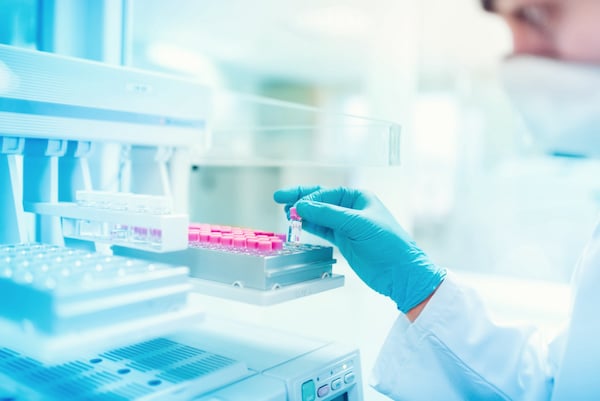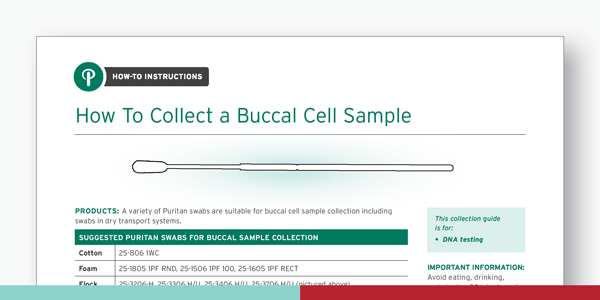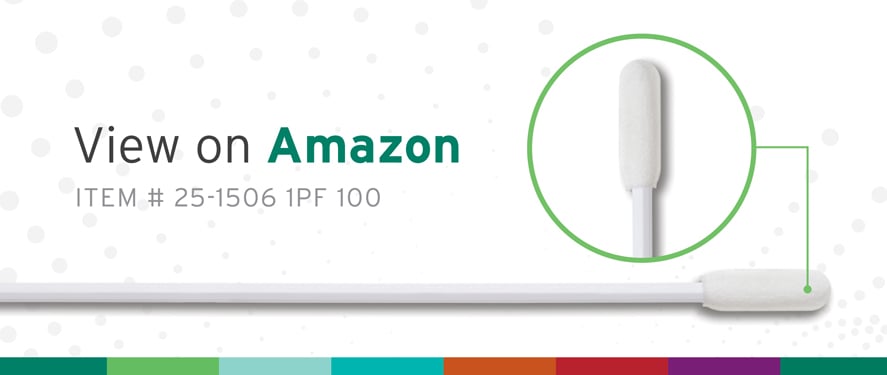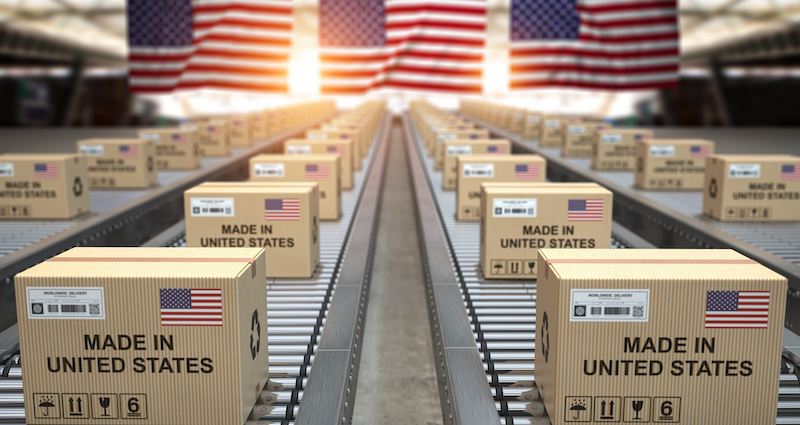
Buccal cell collection is a critical element of forensic analysis. In this article, we’ll discuss what buccal cells are, why they’re used for DNA and forensic analysis, and the best swab type to use for this specimen collection.
What is a buccal cell?
Buccal cells are the flat and thin cells that line your cheeks and lips. Unlike other common cell types, buccal cells are constantly shed and replenished with new cells. Buccal cells are most commonly collected for DNA analysis and testing, culture experiments, and microscopic analysis.
Buccal cell collection with a swab is one of the fastest and most common ways for forensic pathologists to establish or refute a link between a suspect and a crime scene. This is accomplished by comparing touch DNA evidence from the crime scene with reference samples (also known as elimination samples) of buccal cells collected from various suspects. When there’s a match, investigators can link a suspect to the scene of a crime with certainty.
Why is Swabbing for buccal cells the ideal method for the collection of DNA Evidence?
Many law enforcement facilities prefer collection of buccal cells by swabbing to other sample collection methods because it is fast, non-invasive, relatively comfortable, and can yield larger sample sizes than other collection methods.
There are many reasons to prefer buccal cell collection, including:
1. Buccal Cell Collection With a Swab Is Non-Invasive and Easy
Unlike other DNA collection methods, is no need to poke, prod, or draw blood to get a great sample. For the individual being tested, the procedure is easy, fast, and most importantly - painless. Buccal cells are easily accessible. All you need to do is have the subject open his/her mouth. This makes it easy to collect samples regardless of age, gender, or health status.
2. Buccal Cells Have High Stability
A buccal cell specimen is ideal for evidence collection because it remains stable for a long time. This makes it easy to store. Most importantly, this stability makes it easy for forensic pathologists to analyze (or re-analyze) over time, another reason why many researchers prefer using buccal cells.
3. Buccal Cells Provide Reliable DNA Quality
As we said before, buccal cells are constantly being replenished in the mouth. They provide high-quality samples that can be used for PCR testing, genetic sequencing, microarray analysis, and most importantly - forensic analysis.
Now that you understand some of the benefits, let’s talk about how to get started.
The first step in effective buccal swab sample collection is to make sure you’ve got the right tools on hand.
How to Build a Buccal Swab Collection Kit
A buccal swab collection kit is a kit that your team can easily transport from scene to scene and contains all the materials needed to collect a buccal sample from individuals and suspects. Your kit should include swabs, gloves, and a mask, among other items.
Your department’s buccal swab collection kit doesn’t have to be fancy, but it should contain everything an individual would need in order to conduct and transport a buccal cell sample.
Generally, buccal swab kits should contain the following:
- Two sterile swabs with cotton, foam, or flocked tips
- Two pairs of gloves
- A surgical mask
- Dry transport tubes or sterile collection envelopes
- A few strips of evidence tape
- Swabbing instructions
- Consent form (if required by jurisdiction)
- Clean pen
Your vision, realized - Puritan Medical Products takes you from concept to commercial production seamlessly. Invest in top-quality custom buccal swab kits crafted exclusively for your needs.
How to Collect a Buccal Swab Sample
Buccal cell collection by swabbing is relatively convenient because it generally doesn’t require a medically trained professional. With some simple training, almost anyone can collect a buccal swab sample for forensic analysis. In fact, we've created a step-by-step video to show you how to do exactly that:
Step 1: Your subject should avoid eating, drinking, and any nicotine products 30 minutes prior to collection. Verify that the subject’s mouth is empty.
Step 2: Wash or sanitize your hands, and then put on any personal protective equipment. This can include gloves and a mask.
Step 3: Choose a sterile cotton, foam, or flocked swab.
Step 4: Carefully remove your swab from its package. Be sure to avoid touching the swab tip with your gloves or against any surfaces. Touching the swab tip to anything other than the inside of the subject’s mouth may result in a contaminated sample.
Step 5: Hold the swab securely by the swab’s handle, as close to the end as possible. If the swab has a breakpoint indicator on the handle, do not touch the swab above the breakpoint indicator mark.
Step 6: Have the subject open their mouth and immediately bring the swab tip to the inside of the cheek.
Step 7: Firmly rub and rotate the swab along the inside of the cheek for 5-10 seconds, ensuring that the entire swab tip has made contact with the cheek.
Step 8: Now, repeat step 7 on the other side of the mouth with the same swab.
Step 9: Immediately remove the swab, being careful not to touch the swab tip against the teeth, lips, or other surfaces.
Step 10: IMPORTANT: The swab should be allowed to air dry before it is placed in a closed container for storage. Immediately place the swab in an aerated or air permeable container, such as the Cap-Shure®, FABUSA or paper wrapper, or, place the dried swab into a dry transport tube.
Step 11: Label the tube or envelope with identifying information. Use evidence tape to seal the outer packaging. Initial and date for the chain of custody verification. Store the swab at room temperature or transfer it to the freezer until testing.
Check out our step-by-step video if you want to see these steps in action:
What Are the Different Types of Buccal Swabs?
Not all buccal swabs are created equal. To build a custom buccal swab collection kit specific to the needs of your department, speak with your lab manager to determine the requirements or collection priorities of your lab.
Sterile Foam Tipped Buccal Swabs
Due to their high particle collection capacity and soft tips, medical grade foam tipped swabs are generally the most popular swab-type for buccal cell collection. Foam tipped swabs can range in size from tiny (to minimize subject discomfort) to large (for high article collection capacity). Here are a few of the most popular Puritan foam swabs for buccal cell collection:
- Large Round DNA Free Foam Tipped Swab
- Foam Tipped Applicator Swab with Hollow Polystyrene Shaft
- Small Rectangular Foam Tipped Swab With Polypropylene Handle
Sterile Flocked Buccal Swabs
Because of their superior collection and elution properties, flocked swabs are quickly gaining popularity for buccal cell collection. The patented flocking pattern of Puritan’s flocked swabs traps more specimen within its proprietary micro-channels than traditional swabs. Here are a few of our favorites for buccal smear collection:
- DNA Free, Ultra Flocked Swab with Transport Tube
- HydraFlock® Flocked Swab, Standard Tip
- HydraFlock® Flocked Swab, Elongated Tip
Sterile Cotton Tipped Buccal Swabs
Finally, due to their versatility and affordability, cotton-tipped swabs are also a popular choice for police department forensic labs. Here are a few of our most popular swabs for buccal cell collection:
- DNA Free Cotton Tipped Applicator
- DNA Free Cotton Tipped Applicators with Dry Transport Tube
- DNA Controlled Cotton Tipped Applicator with Transport Tube
Want to learn more about how to collect a buccal cell sample for forensic analysis, or which swabs to choose for your buccal swab collection kit? Contact one of our knowledgeable product specialists today.
Editor's note: This post was originally published Aug 25, 2014, and was updated on March 9, 2023, for accuracy and comprehensiveness.
SOURCES:
Giamanco, Chantel Marie. Collecting a Buccal Swab – An Art or a Cinch? Forensic Scientist Human Identification Technologies, Inc. Retrieved August 19 from http://www.hitdna.com/images/PDFs/publications/Taking%20a%20Buccal%20Swab.pdf
Collection Techniques. DNA Analyst Training. NFSTC Science Serving Justice®. Retrieved August 19 from http://www.nfstc.org/pdi/Subject01/pdi_s01_m01_05_a.htm.
Schiro G. Collection and Preservation of Evidence. In: Muth AS, editor. Forensic Medicine Sourcebook. Detroit: Omnigraphics, 1999; 45-59. Retrieved August 19 from http://www.forensicscienceresources.com/CAPE3.htm







